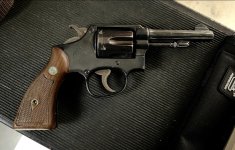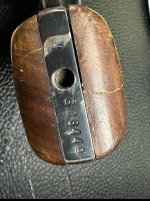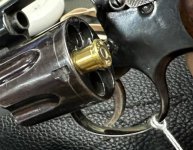TargetVictory
Member
- Joined
- Mar 5, 2025
- Messages
- 13
- Reaction score
- 12
Hi,
It was suggested in a FB group to come here and share:
I recently picked this Victory model up and it was a real head scratcher trying to figure out exactly what it was chambered for and what was original and what was not. From pictures, it was equally divided between 38 S&W and .38 Special. It was settled when S&W fit in the cylinder and Special didn’t, until I saw that the cylinder had a markedly different finish than the rest of the gun. So back to the drawing board.
I did fire 12 38 S&W rounds through it when I got it for a song (it was to be demilled and sold as a wall hanger) and it went ok. I’m glad I didn’t lose an appendage.
I took it to a gunsmith, he worked on it for a few weeks and when I came to pick it up today, it started a shop argument that led to taking apart other old Model 10s to see what fit and what didn’t.
The conclusion we arrived at is that while the cylinder is the only item to retain original finish and everything else matches to a middle of the road bluing refinish, the barrel is what’s incorrect. Everything is 38 S&W, while the barrel is .38 Special.
It does fire, but won’t win any competitions (beauty or performance) and with how long it’s been this way (easily 40 years) and how much I paid (under 100), I’m on the fence about sourcing a new barrel.
What do you think? As was suggested to me to ask here, does anyone have a S&W barrel in their parts boxes they’d be willing to deal on that would fit? Maybe it deserves a real second life.
Thanks for having me.
It was suggested in a FB group to come here and share:
I recently picked this Victory model up and it was a real head scratcher trying to figure out exactly what it was chambered for and what was original and what was not. From pictures, it was equally divided between 38 S&W and .38 Special. It was settled when S&W fit in the cylinder and Special didn’t, until I saw that the cylinder had a markedly different finish than the rest of the gun. So back to the drawing board.
I did fire 12 38 S&W rounds through it when I got it for a song (it was to be demilled and sold as a wall hanger) and it went ok. I’m glad I didn’t lose an appendage.
I took it to a gunsmith, he worked on it for a few weeks and when I came to pick it up today, it started a shop argument that led to taking apart other old Model 10s to see what fit and what didn’t.
The conclusion we arrived at is that while the cylinder is the only item to retain original finish and everything else matches to a middle of the road bluing refinish, the barrel is what’s incorrect. Everything is 38 S&W, while the barrel is .38 Special.
It does fire, but won’t win any competitions (beauty or performance) and with how long it’s been this way (easily 40 years) and how much I paid (under 100), I’m on the fence about sourcing a new barrel.
What do you think? As was suggested to me to ask here, does anyone have a S&W barrel in their parts boxes they’d be willing to deal on that would fit? Maybe it deserves a real second life.
Thanks for having me.




